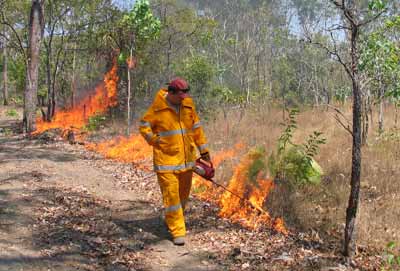Burning operations
Much of the basic fire behaviour information in this Fire Fundamentals section is of direct use to fire managers, and is vital to know for burning operations.
In this course however we can only briefly touch on the practicalities of burning operations: most of this basic summary is contained in Savanna Burning. Should you require more information and practical experience it would be strongly recommended that you do the Wildfire Fighting Operations training course with the Bushfires Council NT.
Role of the Bushfires NT
Bushfires NT advises on effective fire management on rural land (except that immediately surrounding urban areas) throughout the Territory. Contained within the aims and objectives of the Bushfires NT is the prevention and control of fires. Bushfires NT policy stresses the need for individual landholders, be they public or private, to have fire management plans in place which are in the main devoted to the pre-suppression of large and intense fires.
The Fire and Emergency Services Authority of Western Australia and the Queensland Fire and Rescue Service carry out a similar job to the Bushfires NT, in both Western Australia and Queensland respectively.
Planned and wildfires
Fire managers distinguish between prescribed burning and fire suppression. Prescribed burning applies to intentional management fires, lit to achieve specific management outcomes. In contrast, fire suppression is concerned with controlling wildfires, and relates to ensuring a rapid response to immediate fire threats.
Role of fire behaviour in management
In terms of managing both prescribed and wildfires, it is vital to have a good understanding of fire behaviour, particularly that relating to fuel loads, moisture and fire weather. The Fire Fundamental section will have given you a basic knowledge of fire behaviour and its importance to fire managers.
Activity: Fire behaviour and fire management
How does fire behaviour affect management?
Fire behaviour and weather conditions can influence burning operations and determine what fire management can be applied. Refresh your memory about the importance of fuel loads and weather to fire behaviour with the following reading.
Reading:
Dyer, R., Jacklyn, P., Partridge, I., Russell-Smith, J. & Williams, R. (2001) Savanna Burning: understanding and using fire in northern Australia, pp. 82-84. Tropical Savannas CRC, Darwin.
Lighting management fires
When applying fire to the landscape, burns can either be put in on the ground or aerially. Typically prescribed ground fires are either put in using drip torches (fire bugs), matches or capsule launchers depending on the burning objectives and land manager preference.

Lighting up with a drip torch
Drip torches drip lighted fuel onto dry grass, and are mostly used for line or perimeter ignitions. As a management tool matches tend to be used primarily by Indigenous land managers for setting small scale, patchy fires. Capsule launchers propel incendiaries from a vehicle and are useful to widen firebreaks.
Aerial fires involve dropping incendiaries from aircraft. This type of approach is useful for remote areas which are difficult to access by road, and can be used to place strategic fire breaks to help prevent the spread of late season wildfires.
Activity: Head & back fires
When is ignition type important?
Fires can differ in intensity, flame height, rate of spread, and speed of front formation depending on whether they are head or back fires, or line of point ignitions.
In the following reading you will learn about how these different fires are applied in burning operations.
Reading:
Dyer, R., Jacklyn, P., Partridge, I., Russell-Smith, J. & Williams, R. (2001) Savanna Burning: understanding and using fire in northern Australia, p. 88. Tropical Savannas CRC, Darwin.
Firebreaks
Firebreaks are used with the aim of preventing fires from moving onto land that is to be protected from fire or should remain unburned at that moment in time. A fire break may be a road or trail, a mowed or graded line, a natural feature such as a creek or billabong, or a recently burned area. Water or fire retardant foam may also be sprayed down in a line to create a fire break. Managers can use fire breaks to control prescribed or wildfires.